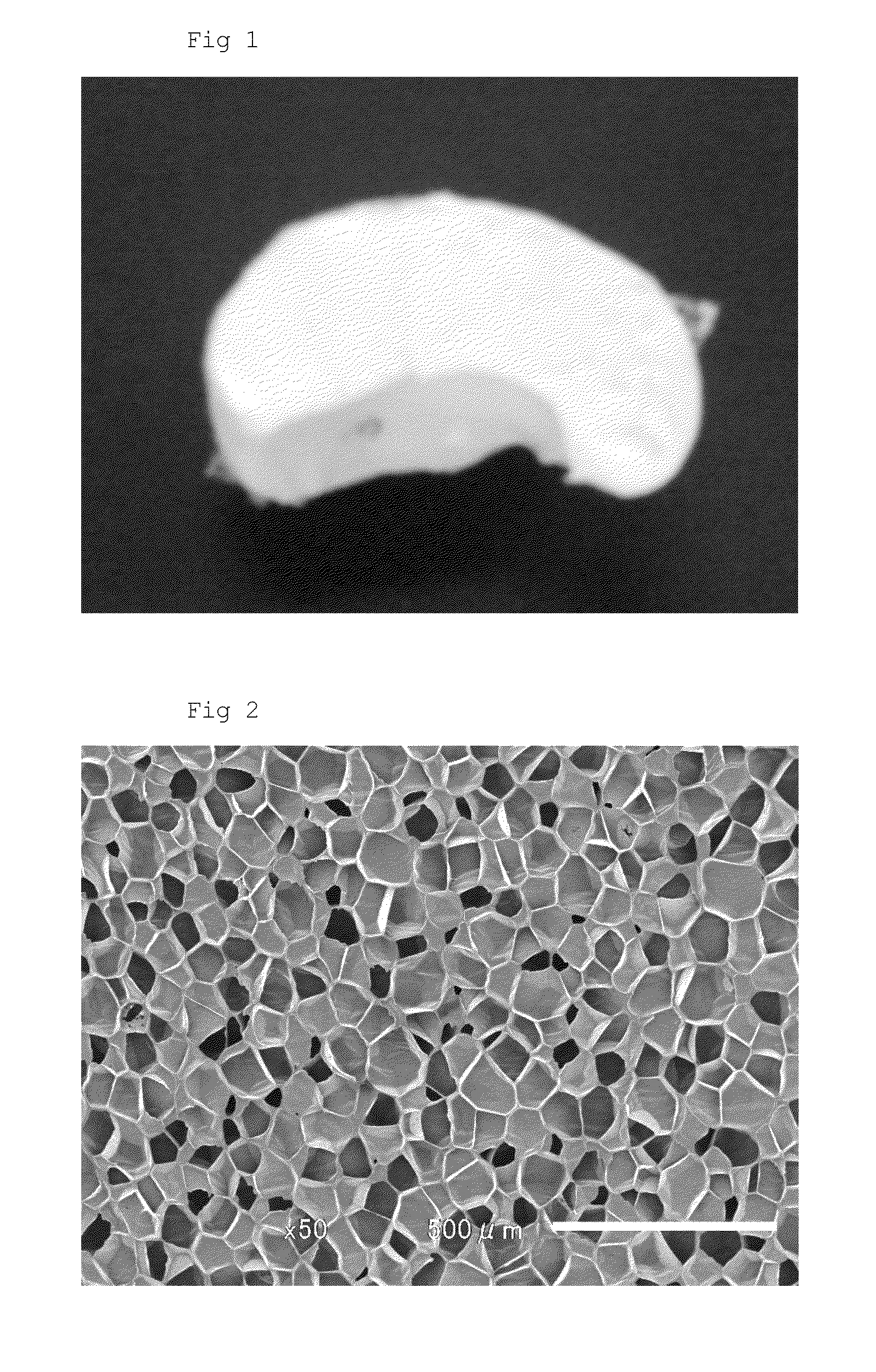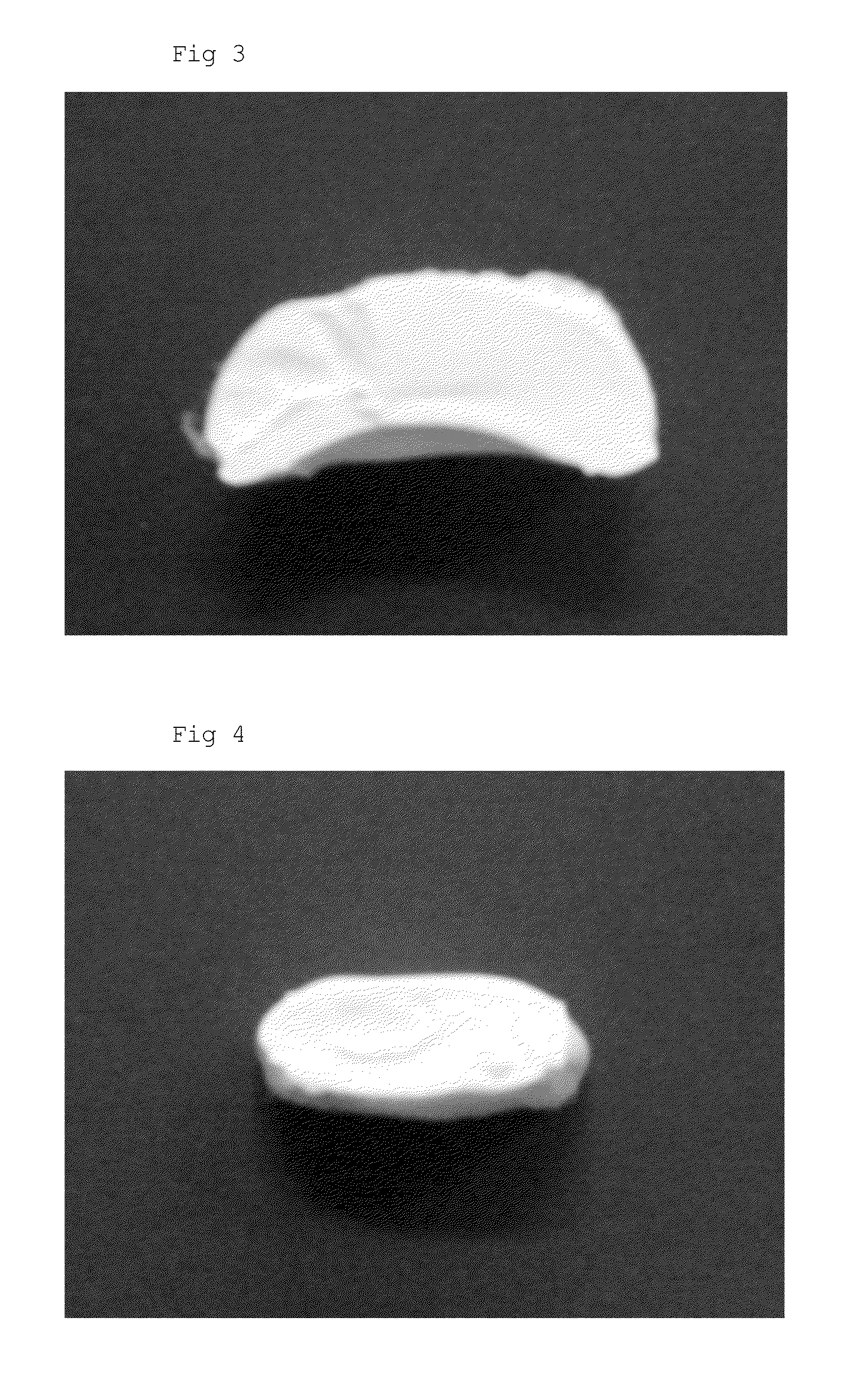Propylene-based copolymer, propylene-based copolymer composition, molded product thereof and foamed product thereof, and production process therefor
a technology of propylene-based copolymer and propylene-based copolymer composition, which is applied in the field of propylene-based copolymer, propylene-based copolymer composition, molded product thereof, foamed product thereof, can solve the problems of increasing the melt viscosity of olefin-based resin, complicated process, etc., and achieves excellent molding processability, increased melt tension of an olefin, and excellent expansion ratio
- Summary
- Abstract
- Description
- Claims
- Application Information
AI Technical Summary
Benefits of technology
Problems solved by technology
Method used
Image
Examples
example 1
A-1
[0561]In a SUS polymerization apparatus having a volume of 1500 ml and equipped with a stirring blade, which had been thoroughly purged with nitrogen, 750 ml of dry hexane of 23° C., 5 ml of 5-vinyl-2-norbornene and 0.75 mmol of triisobutylaluminum (TIBAl) were placed at ordinary temperature, then the internal temperature of the polymerization apparatus was raised to 80° C., and 500 ml of hydrogen was introduced. The polymerization apparatus was pressurized to 0.5 MPa (system pressure) with propylene, and thereafter, the system pressure was adjusted to 0.75 MPa with ethylene. Subsequently, 0.00075 mmol of di(p-chlorophenyl)methylene(cyclopentadienyl)(octamethyloctahydrodibenzofluorenyl)zirconium dichloride and 0.00375 mmol of triphenylcarbenium tetrakis(pentafluorophenyl) borate were introduced into the polymerizer, and polymerization was carried out for 10 minutes while maintaining the internal temperature at 80° C. and the system pressure at 0.75 MPa. Then, 20 ml of methanol wa...
example 2
A-2
[0562]In a SUS polymerization apparatus having a volume of 1500 ml and equipped with a stirring blade, which had been thoroughly purged with nitrogen, 750 ml of dry hexane of 23° C., 5 ml of 5-vinyl-2-norbornene and 0.75 mmol of triisobutylaluminum (TIBAl) were placed at ordinary temperature, then the internal temperature of the polymerization apparatus was raised to 80° C., and 400 ml of hydrogen was introduced. The polymerization apparatus was pressurized to 0.5 MPa (system pressure) with propylene, and thereafter, the system pressure was adjusted to 0.75 MPa with ethylene. Subsequently, 0.00075 mmol of di(p-chlorophenyl)methylene(cyclopentadienyl)(octamethyloctahydrodibenzofluorenyl)zirconium dichloride and 0.00375 mmol of triphenylcarbenium tetrakis(pentafluorophenyl)borate were introduced into the polymerizer, and polymerization was carried out for 10 minutes while maintaining the internal temperature at 80° C. and the system pressure at 0.75 MPa. Then, 20 ml of methanol was...
example 3
A-3
[0563]In a SUS polymerization apparatus having a volume of 1500 ml and equipped with a stirring blade, which had been thoroughly purged with nitrogen, 750 ml of dry hexane of 23° C., 9 ml of 5-vinyl-2-norbornene and 0.75 mmol of triisobutylaluminum (TIBAl) were placed at ordinary temperature, then the internal temperature of the polymerization apparatus was raised to 80° C., and 400 ml of hydrogen was introduced. The polymerization apparatus was pressurized to 0.5 MPa (system pressure) with propylene, and thereafter, the system pressure was adjusted to 0.75 MPa with ethylene. Subsequently, 0.00075 mmol of di(p-chlorophenyl)methylene(cyclopentadienyl)(octamethyloctahydrodibenzofluorenyl)zirconium dichloride and 0.00375 mmol of triphenylcarbenium tetrakis(pentafluorophenyl)borate were introduced into the polymerizer, and polymerization was carried out for 10 minutes while maintaining the internal temperature at 80° C. and the system pressure at 0.75 MPa. Then, 20 ml of methanol was...
PUM
| Property | Measurement | Unit |
|---|---|---|
| glass transition point | aaaaa | aaaaa |
| glass transition point | aaaaa | aaaaa |
| glass transition point | aaaaa | aaaaa |
Abstract
Description
Claims
Application Information
 Login to View More
Login to View More - R&D
- Intellectual Property
- Life Sciences
- Materials
- Tech Scout
- Unparalleled Data Quality
- Higher Quality Content
- 60% Fewer Hallucinations
Browse by: Latest US Patents, China's latest patents, Technical Efficacy Thesaurus, Application Domain, Technology Topic, Popular Technical Reports.
© 2025 PatSnap. All rights reserved.Legal|Privacy policy|Modern Slavery Act Transparency Statement|Sitemap|About US| Contact US: help@patsnap.com



